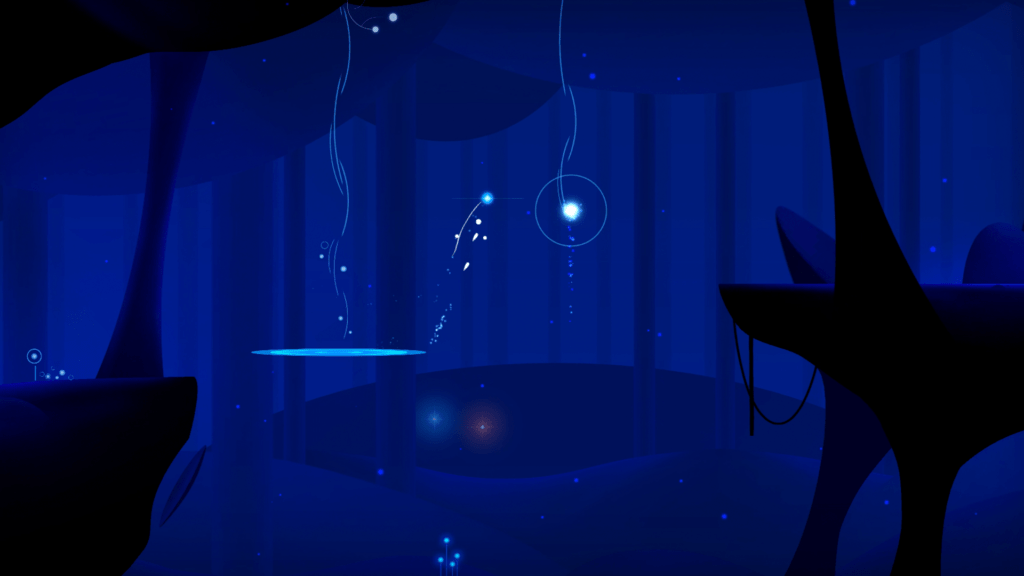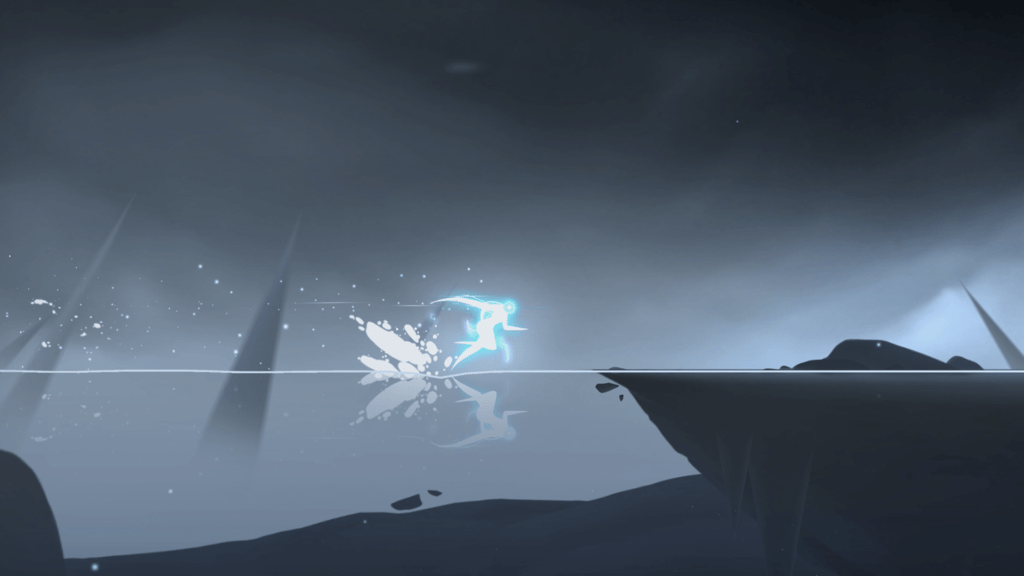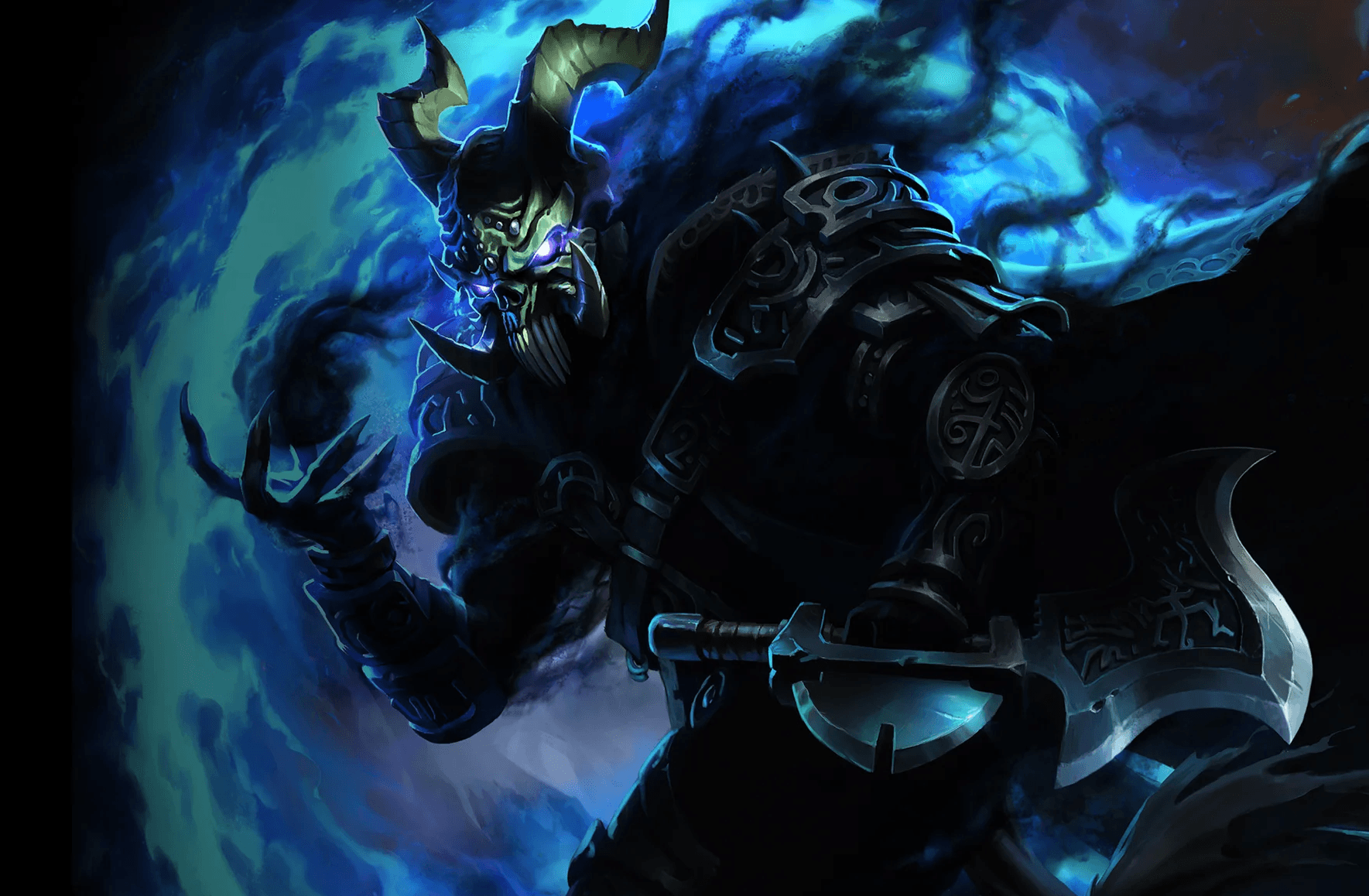The first thing that caught my eye about Worldless was its look. Worldless presents an austere world that’s become a battleground for two opposing forces, blue and orange, light and dark. Polar opposites drawn into conflict by their nature. Each zone you wander through is beautiful and tranquil, the music carrying a similar calm, airy quality, a strong contrast to the fights playing out in the background. Creatures and humanoid figures both clash in a dazzling spectacle, a constant reminder of war being waged all around you.
You begin as one of the white beings, newly formed and thrust straight into battle. Their first fight ends in a draw as they and their opponent suddenly have a moment of resonance as signaled by a sudden burst of green light, separating them immediately after. They end up in a sort of limbo where they meet one of the original denizens of this world, quite possibly the sole survivor given how common a sight the corpses of their brethren are. They speak of the history of this world in vague terms, of the current conflict and the motivations behind it (“Ones looking to change their nature. The others, trying to preserve it”), and allusions toward a greater force at play.
Eventually the two figures meet again and, following another fight, choose to work together. These two act as the protagonists of Worldless. Each has their own set of abilities in and out of combat. The white and blue one is able to air dash, wall jump, and run across water and up walls, while the black and orange one can double-jump, move underwater, and use a grappling hook. These abilities are slowly earned over the course of Worldless, allowing access to more of the world and encouraging regular backtracking. Using their abilities in tandem, switching back and forth while leaping around, sees Worldless at some of its best.

It captures the simple pleasures of platforming and exploration well. There’s seldom any challenge to traversing the world, but it always feels good and looks cool. There’s a particular grace with which the two player characters move that makes every action satisfying to perform. Good movement needs to look as good as it feels, and Worldless pulls it off effortlessly.
The second thing that caught my eye about Worldless was its combat. Worldless is a particular kind of turn-based action. It takes the stylish fast-paced play of character action games and transposes it onto a turn-based framework. It works like this: when your turn comes up, you have a set amount of time to do whatever attacks you please. When time expires, your turn ends and the opponent’s begins. You and your opponent are largely constrained by the turn-based design, only able to act in the time allotted for your turn, but it’s not strictly a binary state.
As you learn more abilities, you open up ways to directly counter and prematurely end the opponent’s turn or use their own attacks against them instead. Likewise they eventually start counterattacking during your turn as well. Fights transform from a simple back and forth into taxing duels as you try to work out how to dismantle their defenses and learn their attack patterns and the appropriate response. Combat is already thrilling just to watch — the way everyone moves, attacks clashing and spells lighting up the screen, is entrancing — but it becomes so much more once all the systems fully come into play.

Every fight is effectively a puzzle. How do you break their defenses and fill the absorption gauge without slaying the opponent first? Absorption is key because doing so allows you to unlock more skills using the opponent’s essence. But to do so, you have to figure out how best to fill that gauge. Just mashing a basic combo quickly leads to diminishing returns. Repeating actions weakens their strength. You’re encouraged to use the full spread of your abilities, constantly swapping between physical and magical attacks, ranged and close-quarters combat as necessary.
It’s a lot to keep track of. I always had to remind myself to make use of all my tools rather than just rotate through a couple of them because, though less effective it may be, I could still get the job done by doing that. I would often just enter a fight with whichever of the two characters I had active at the moment and see how far I could get with them until I needed to switch to use a certain spell. Hardly optimal, but worked well enough to scout out my opponent and start putting together a strategy.
Worldless doesn’t have any sort of failure state — losing a fight just means you have to try again or come back later — but its difficulty is still pronounced all the same. It primarily manifests in learning how to properly time your blocks and dodges to avoid losing ground on the absorption gauge.

Worldless is a game that loves timed button presses. Time a block well and you’ll get a perfect block, which negates damage entirely rather than chip away at your barrier and powers a parry that ends the opponent’s turn and can go straight into damage. Or deflect by blocking and then releasing the button at the right moment to use the enemy’s attacks against them and power up a move that will absorb an enemy spell and heal you in the process. Additionally, timing each hit of your attacks allows you to deal an extra, more powerful move to end the combo with or allow you to move from a ranged attack string into a melee one instantly.
The key is that Worldless is fair. A mistimed block won’t lead to you taking direct damage, nor will failing to properly deflect penalize you. You’ll still negate or heavily reduce damage in either case. Worldless isn’t interested in punishing mistakes as it is in pushing you to try to make the most of your abilities. If I couldn’t reliably block something properly, then it was time to deflect or dodge instead. Likewise, if I kept getting the timing on the dodge wrong, then it was time to hunker down and block.
The process of learning how to fight each foe is a constant thrill. Seldom does Worldless pit you against the same foe twice, making almost every fight unique. The tactics they employ and the methods needed to best them are varied and sometimes challenging to execute. The bigger, more traditional boss fights are high on spectacle, regularly launching intense attack sequences and massive strikes that are especially hard to counter. They’re easily the most thrilling to fight because of the constant change in tactics and how much they feel like uphill battles. Every time I won it was a close call. Every time I had to really push to make the absolute most of everything at my disposal.

Even when I did encounter a foe I’d fought before, it’d usually be one that wasn’t easy to beat the first time around. An example: there was this dark, sort of amorphous creature that I ran into a couple times. It starts the fight by lurching forward slightly. To attack it, you need to first break through its barrier using whatever you can because there’s no highlighted weakness. But it also has a health bar that is still taking damage with each hit. The challenge then is one of a balancing act: breaking through defenses quickly to start attacking directly to fill the absorption gauge, but not so recklessly that you deplete the health bar first. Also you need to do all this before the creature reaches you.
The turn-based framework shines here. That you have only so much time available per turn makes every action count, the ever ticking down clock forcing quick decision making. Having to take actual turns means you have to make the absolute most of when you can act since you can’t throw yourself recklessly at the opponent until you win. It creates a specific tempo where fights are rarely one-sided, but rather constantly on the verge of tipping back and forth.
I can’t count the number of times I almost secured victory only to fail to dodge or block something correctly and lose a good deal of progress on the absorption gauge. A single good hit can do a lot to undo all that hard work. The challenge from then on was one of not letting myself lose focus, of maintaining a cool head to avoid recklessness. I was often in a bad spot health-wise in these circumstances, so a couple mistakes could easily spell the end for me.
At its best, Worldless captures the thrill of a good close fight. That feeling of knowing exactly what you need to do — you just need to execute on it. Those tense moments where you know a big attack is coming and you think you’ve got the timing down to block or avoid it properly, but it’s coming right when that one hit is all it’ll take to defeat you — or, conversely, they’re in that position and you just need to get past this last hit to deal the final blow. In those moments, when everything clicks together, Worldless shines.





